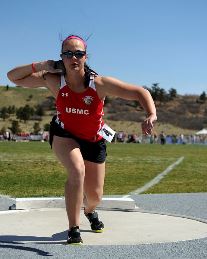Sports
Track and Field: Throwing Events
 Source: US Air Force
Source: US Air Force
Discus
In the discus event the athlete throws a round disc, typically made of plastic with a metal rim. The men's college and Olympic discus weighs 2 kilograms (4.4 pounds). The women's college and Olympic discus weighs 1 kilogram (2.2 pounds). The discus is thrown from a concrete circle that is about 8 feet in diameter. The athlete's feet can't leave the circle before the discus lands or the athlete will fault and the throw won't count. The athlete will spin around to gain momentum and speed and then release the discus in the proper direction. The athlete that throws it furthest from the front part of the circle (and within the legal area) wins.
Javelin
The javelin is something like a spear. This event should be supervised at all levels to be sure no one is hurt. The men's college and Olympic javelin weighs 800 grams (28.2 ounces) and is about 8.5 feet long. The women's college and Olympic javelin weighs 600 grams (21 ounces) and is about 7 feet long. The javelin must be thrown a specific way for it to be a legal throw. With the javelin an athlete has to:
- 1) Hold the javelin by its grip and nowhere else
- 2) Throw the javelin overhand (we're not sure underhand would work too well anyway)
- 3) They cannot turn their back to the target when throwing (this means they can't spin)
When throwing the javelin, the athlete jogs down a runway to gain momentum and then must throw the javelin prior to crossing a line. The athlete cannot go over the line until the javelin lands which means the athlete needs to leave some extra space to slow down and have really good balance at the end of the throw. The athlete that throws it furthest (and within the legal area) wins.
Shot Put
In the shot put event athletes throw a metal ball. The men's college and Olympic shot weighs 16 pounds. The women's college and Olympic shot weighs 4 kilograms (8.8 pounds). This sport actually started with a cannonball throwing competition in the Middle Ages. The shot is thrown from a concrete circle that is 7 feet in diameter. The front of the circle has a metal board called a toe board. The athlete cannot touch the top of the toe board or step over it during the throw. The athlete holds the shot close to his/her neck in one hand. There are two common throwing techniques: The first has the athlete slide or "glide" from the back to the front of the circle before releasing the shot. The second has the athlete spin in the circle (like the discus) before releasing the shot. With either technique the goal is to build momentum and finally push or "put" the shot in the direction of the legal landing area. The athlete must stay in a circle until the shot has landed. The athlete that throws it furthest from the front part of the circle (and within the legal area) wins.
 Shot put thrower
Shot put thrower
Source: US Marine Corps
The hammer throw doesn't actually involve throwing a hammer like you would think. In this track and field throwing event the athlete throws a metal ball attached to a handle and a straight wire about 3 feet long. The men's college and Olympic hammer weighs 16 pounds. The women's college and Olympic hammer weighs 4 kilograms (8.8 pounds). The hammer is thrown from a concrete circle 7 feet in diameter (just like the shot put) but there is no toe board. Like the discus and the shot put, the athlete must stay in a circle until the hammer lands. The athlete spins several times to gain momentum prior to releasing and throwing the hammer. Balance is important due to the force generated by having the heavy ball at the end of the wire. The athlete that throws it furthest from the front part of the circle (and within the legal area) wins.
Running Events
Jumping Events
Throwing Events
Track and Field Meets
IAAF
Track and Field Glossary and Terms
Athletes
Jesse Owens
Jackie Joyner-Kersee
Usain Bolt
Carl Lewis
Kenenisa Bekele

